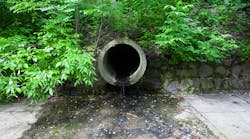STORMWATER: When we spoke last, we discussed the increased use of PPE and more focus on safety measures, and some of the benefits monitoring equipment like sondes and sensors can offer when physical distance is important. What, if anything, has changed in the last several months? Has the process of getting people and equipment to sites become any smoother? Are there any operating procedures that you’ve seen adopted you think will stick around?
ERIN ROTHMAN: When you have a team that has worked together in these conditions before, everything kind of melds and you develop a system that keeps things moving quickly and smoothly. It’s like working in any tough conditions. It creates a kind of bond and a camaraderie that turns a challenge into a story of yet another problem you were able to work through together.
In addition, we’ve really focused on streamlining our installation process to make sure we can do it as quickly as possible with as small a team as possible. I think efficiencies like these will absolutely stick around.
SW: In the early days of the COVID-19 pandemic, there was hope that it would be resolved rather quickly, either through significant containment or a substantial and long-lasting flattening of the curve. Now, it seems restrictions on gatherings and close contact will be with us for many more months to come. How have your long- and short-term plans changed since the beginning of the pandemic? Have you noticed any shifts in planning among communities, agencies, and others you work with?
ER: As with most companies, we’ve certainly seen some benefits of working from home that we didn’t recognize before. I never thought about how much time I spent on my commute, or on my way to the airport/hotel/train/rental car facility, and waiting at these places. Now, when I think about going through all of that again and losing so much time, I get a little tense! Remote work also opens up huge opportunities for us to expand our employee/hiring networks and engage teams elsewhere in the country, working more directly with our customers on a regular basis.
Our planning has allowed us to focus on productivity and product improvements, with people working their best hours for their best work. We also recognize that city budgets are going to be tight for a while yet, and we’re working with our customers to develop projects that work for what they need and what they can do right now. We’re seeing more phased projects, for example, or projects that focus on really high-impact areas first and expanding from there.
The last thing cities need—on top of everything else they’re dealing with—is another disaster, whether it’s a flood or a water backup, that forces people from their homes. Helping them avoid that risk while managing their spend effectively is paramount.
SW: In a physically distanced world, some of the benefits of monitoring seem self-evident, but has the last year changed how you approach talking about the benefits of sensors, sondes, and monitoring in general?
ER: With reduced staff working onsite, and with budget reductions overall, being able to monitor infrastructure remotely, and ideally from your desk, just makes sense. Remote monitoring reduces exposure risk and limits unnecessary (and especially now, high-risk) maintenance visits while prioritizing higher-value work.
While the overall concept remains the same, the risk mitigation component of remote monitoring absolutely comes to the forefront of our discussions more often.
SW: Are you feeling optimistic, or cautious, about the year ahead? Why?
ER: Optimistic! I think, with the new administration coming into office, we should expect to see some additional infrastructure-related spending push through Congress and to state and local governments. That will be a huge relief to our cities, especially given the pandemic-related impacts to city budgets. I think we’re learning to work with this virus safely and, with the vaccine in hand, we will start to see progress toward eliminating it altogether. If we can get through this, we can get through anything!
SW: What has been the most significant change you’ve made in how you approach your work in the stormwater sector? What lessons or shifts do you think the industry at large should take into consideration in the new year?
The importance of highlighting the value of efficiency for our customers: Illustrating how to streamline installation, make the software super intuitive and easy to use, fast-tracking new feature releases, and focusing on data quality and system insights. I think this level of efficiency and system intelligence will become the new normal in stormwater, as it has in parallel industries. We are at a great place from which to move toward. SW






